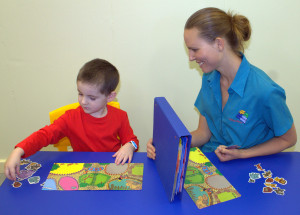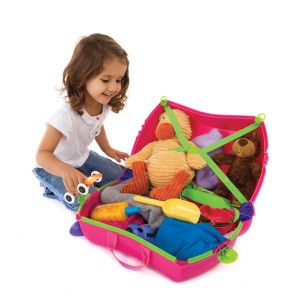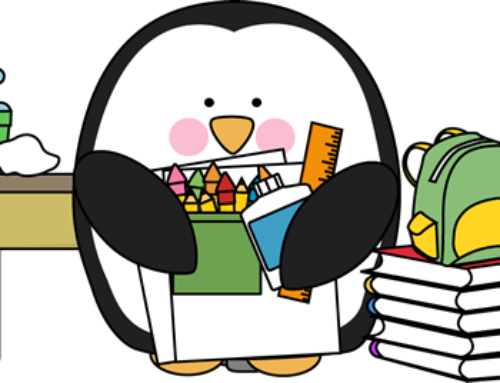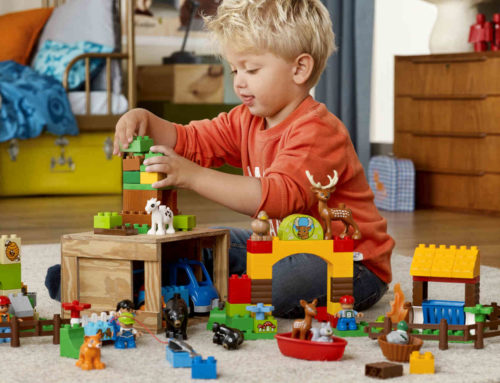
When it comes to a child’s education, we know there is more to it than spelling words and times tables. However, sometimes it can be hard for parents to move past the old “Reading, Writing and Arithmetic” mantra.
We know how important it is for children to have confidence and develop their skills in reading, writing and mathematics. We help them learn sight words, we practice spelling lists, we check their equations and we listen to them practice their home readers because we know how valuable and important those skills are. However, there are some other skills that are equally as important but often slip under the radar… Talking and listening skills!
It’s easy to overlook talking and listening because it’s something we do automatically all day, everyday. When the phone rings we don’t have to stop and think “Hmm what should I say when I answer this?”. When we pick up the kids from school “How was your day?” rolls off the tongue without a second thought.
As adults we tend not to think about just how far we’ve come from the moment we said our first word, and sometimes we forget just how much more there is for our children to learn. When a child starts school they will know between 2100 and 2200 words. By the time they are 12 years old they will understand about 50,000 words!
It’s important to give our children lots of different opportunities to practice their talking and listening abilities, as just like any other skill, the more you practice, the better you get.
Using simple and repetitive games is a fun way for children to develop their listening skills, which in turn enhances their literacy development. Listening is not just sitting quietly and waiting while someone else speaks. Effective listening skills are the key to a child being able to understand and follow directions and instructions, to understand questions, to remember and organise new information and concepts, to develop new vocabulary and to recognise appropriate grammar. Improving a child’s listening skills also supports their social development and helps them become an active and successful participant in the classroom.
Educators know that a child telling the class their news or having a turn at “show and tell” once a week is not enough. That is why they incorporate lots of quick and fun talking and listening games into their lessons. The great news is that these types of games are just as easy and fun to play at home and won’t cost you a thing!
Here are 10 fun games that you can play to improve your child’s listening skills…
1. I went to the shop…
 In this game the first player starts off by saying, “I went to the shop and I bought… an apple“. The next person continues by repeating what the previous player said and then adding their own item to the shopping list. For example, “I went to the shop and I bought an apple and a banana“. The next person continues, “I went to the shop and I bought an apple, a banana and some cake“.
In this game the first player starts off by saying, “I went to the shop and I bought… an apple“. The next person continues by repeating what the previous player said and then adding their own item to the shopping list. For example, “I went to the shop and I bought an apple and a banana“. The next person continues, “I went to the shop and I bought an apple, a banana and some cake“.
This is a wonderfully simple and very flexible game that I use time and time again. You can play it anywhere, anytime! You don’t have to stick to the shopping theme either. You can adapt it to suit whatever your child is interested in or to revise a topic they are working on at school such as animals (e.g. I went to the zoo and I saw…) or space (e.g. I travelled into space and I saw…).
If you prefer you can list things in alphabetical order. For example, after “I went to the shop and I bought an apple, banana, and cake”, the next person would have to choose an item starting with “d”. Otherwise, you can just let the children pick items at random.
You can decide how the game will end. It may end when a player forgets an item in the list or you may decide that that player is out and the other remaining players continue until there is just one person left. Otherwise, you may decide that there will not be one “winner” and if players are having trouble remembering all the items you may give them a clue (e.g., it’s something yellow that monkeys like to eat), or see if other players can provide the clues to help them remember the missing items
2. Simon Says
 This game is a classic for a reason! It’s a fantastic and fun way for children to practice following instructions and listening carefully. One person plays the role of “Simon” and gives the other players directions to follow such as, “Simon says put your hands on your head” or “Simon Says jump up and down”. If the instruction begins with “Simon Says…” everyone must complete that action. If an instruction is given without saying “Simon says” first however, the players must freeze. Anyone who follows a direction without hearing “Simon Says” first is out!
This game is a classic for a reason! It’s a fantastic and fun way for children to practice following instructions and listening carefully. One person plays the role of “Simon” and gives the other players directions to follow such as, “Simon says put your hands on your head” or “Simon Says jump up and down”. If the instruction begins with “Simon Says…” everyone must complete that action. If an instruction is given without saying “Simon says” first however, the players must freeze. Anyone who follows a direction without hearing “Simon Says” first is out!
Have you got some superhero fans at home? Why not change the game to “Superman Says…”? Princess Party on the horizon… no problem, you can play “Cinderella Says…”.
The beauty of this game is that you can tailor the instructions to be as simple or difficult as you like. For younger children you can keep directions very short and simple such as, “Jump”, “Hop”, “Stand up”, “Sit down”. For older children you can incorporate multiple steps such as, “Stand up, turn around and touch your nose” or introduce concepts such as before and after, “Before you touch your nose, touch your ears”.
3. Barrier Tasks
 A barrier task is a game where two (or more) people are doing the same thing but cannot see each other. You might sit on the floor with your backs to each other, or sit side by side at a table with a book propped up between you both to act as a divider. No peeking! The task might be drawing a picture, building a tower of blocks or using household objects like coloured pegs to create a pattern.
A barrier task is a game where two (or more) people are doing the same thing but cannot see each other. You might sit on the floor with your backs to each other, or sit side by side at a table with a book propped up between you both to act as a divider. No peeking! The task might be drawing a picture, building a tower of blocks or using household objects like coloured pegs to create a pattern.
To complete the task you must ensure that all players have exactly the same materials. For example, if drawing a picture make sure all of the players have the same coloured pencils. One player gives the directions whilst drawing and the other players listen quietly and follow the instructions immediately. They are not allowed to ask questions or look at any of the other pictures. Directions may include things like, “Draw a blue house in the middle of the page. Draw a green tree on the right side of the house. Draw a yellow sun in the top left hand corner of the page”. Once all of the instructions have been given all players turn around and compare pictures.
I often use barrier tasks to work on positional language such as, on top, above, below, under, next to, in between, in front, behind, right, left, in and out. Don’t forget to mix it up and say something unexpected to check that the children are really listening. For example, “Draw a pond next to the tree. Now draw a fish above the tree”.
4. Robot repetition
 In this game you play the role of the inventor and stand on one side of the room. The children are the robots and line up alongside each other at the other end of the room waiting for their turn. The inventor chooses a child/robot and gives them a short sentence such as, “My mum drives a blue car”. If the child repeats it correctly they take a step forward and wait for their next turn. If the child does not repeat the sentence correctly they take a step back. As the robots move forward make the sentences longer and more complex (e.g. “The librarian has twelve new year eight science books reserved for us”). The winner is the first robot to reach the inventor.
In this game you play the role of the inventor and stand on one side of the room. The children are the robots and line up alongside each other at the other end of the room waiting for their turn. The inventor chooses a child/robot and gives them a short sentence such as, “My mum drives a blue car”. If the child repeats it correctly they take a step forward and wait for their next turn. If the child does not repeat the sentence correctly they take a step back. As the robots move forward make the sentences longer and more complex (e.g. “The librarian has twelve new year eight science books reserved for us”). The winner is the first robot to reach the inventor.
Repetition is a very important skill and is much more difficult than most people realise.
Our brain must hear the words, make sense of them and then remember them long enough to complete the direction. It’s an essential skill in the classroom as it is the foundation of following directions and instructions, writing to dictation and successful note taking.
5. Short story detectives
 In this game children listen carefully as you make up a short story (2-3 sentences long). Once they have listened to the story you ask them 3 questions based on any of the Who?, What?, Where?, When?, Why? elements of the story. For younger children start with questions about facts you have explicitly stated. For example your story might be… “On Sunday afternoon, Tom and Jane went to the library. Tom borrowed a book about dinosaurs and Jane borrowed a book about volcanoes”. Your questions might then be, “Who went to the library?” (Tom and Jane), “When did they visit the library? (Sunday afternoon), What book did Tom borrow? (Dinosaurs).
In this game children listen carefully as you make up a short story (2-3 sentences long). Once they have listened to the story you ask them 3 questions based on any of the Who?, What?, Where?, When?, Why? elements of the story. For younger children start with questions about facts you have explicitly stated. For example your story might be… “On Sunday afternoon, Tom and Jane went to the library. Tom borrowed a book about dinosaurs and Jane borrowed a book about volcanoes”. Your questions might then be, “Who went to the library?” (Tom and Jane), “When did they visit the library? (Sunday afternoon), What book did Tom borrow? (Dinosaurs).
For older children you can leave gaps in the storyline and ask questions that require them to make inferences and predictions. For example, the story might be, “Sarah was so annoyed that she had missed the bus. Miss Lawson was going to be furious if she was late again. The day had not started well!”. The questions could be, “Where is Sarah going?” (School/work), “Who is Miss Lawson?” (Her teacher/boss) “Why do you think she missed the bus?” (She couldn’t find her homework/ She slept in). “How will Sarah get to school/work now”? (She will wait for the next bus/ walk).
Don’t forget to have fun with your stories! You could make up a story about Spiderman going to a fish and chip shop to buy a burger for Batman if you think that will go down well.
6. I’m thinking of something…
 The first player thinks of a person, place or thing and without naming it, gives the other players 3 clues to help them guess what is it. The other players must wait for all 3 clues to be given and must repeat all of the clues before they can make a guess. For example, “I’m thinking of something that lives on a farm, likes to roll around in mud and says oink” (pig), or “I’m thinking of someone that has long blonde hair, lives in Arendelle and sings let it go” (Elsa from Frozen).
The first player thinks of a person, place or thing and without naming it, gives the other players 3 clues to help them guess what is it. The other players must wait for all 3 clues to be given and must repeat all of the clues before they can make a guess. For example, “I’m thinking of something that lives on a farm, likes to roll around in mud and says oink” (pig), or “I’m thinking of someone that has long blonde hair, lives in Arendelle and sings let it go” (Elsa from Frozen).
7. Sound tennis
 In this game a sound is chosen such as “p” and the first player has to think of a word that starts with the “p” sound e.g. pizza. The next player has to think of a different “p” word e.g. pig. The game goes back and forth with each player thinking of new words that match the chosen sound. The round ends when a player repeats a word that has already been said, or cannot think of anything new. A new sound is then chosen and the game starts again.
In this game a sound is chosen such as “p” and the first player has to think of a word that starts with the “p” sound e.g. pizza. The next player has to think of a different “p” word e.g. pig. The game goes back and forth with each player thinking of new words that match the chosen sound. The round ends when a player repeats a word that has already been said, or cannot think of anything new. A new sound is then chosen and the game starts again.
For older children you could make this a rhyming game. The chosen sound might be “at” and players take turns naming words (real or made up) that rhyme e.g. cat, hat, mat, splat, gat etc.
8. Odd one out
 In this game you name 3 people, places or things and ask the child to pick the odd one out. At first you may want to start out with items that belong to two very separate categories such as food and animals. For example – “What’s the odd one out… cat, dog, banana”. If the child picks banana tell them that’s right and ask them if they can tell you why? If they pick cat or dog, gently explain that cat and dog go together because they are both animals, and a banana is not an animal, it’s a food so it doesn’t belong. Once they have got the hang of it start to work on sub categories such as, “cow, pig, crocodile” (crocodile is the odd one out because the other two are farm animals).
In this game you name 3 people, places or things and ask the child to pick the odd one out. At first you may want to start out with items that belong to two very separate categories such as food and animals. For example – “What’s the odd one out… cat, dog, banana”. If the child picks banana tell them that’s right and ask them if they can tell you why? If they pick cat or dog, gently explain that cat and dog go together because they are both animals, and a banana is not an animal, it’s a food so it doesn’t belong. Once they have got the hang of it start to work on sub categories such as, “cow, pig, crocodile” (crocodile is the odd one out because the other two are farm animals).
9. Packing a suitcase
 This is a great way to practice following multistep instructions. Get a bag or a box large enough to put several items in and place it in the middle of the room. This is the “suitcase”. Now ask your child to collect several items from around the house to pack into the suitcase. For example, tell them “We need a ball, a shoe and a book. Go!”. Make sure your child waits until the whole direction has been given and you have said go before they run off. See how quickly they can find all three things and bring them back to the suitcase.
This is a great way to practice following multistep instructions. Get a bag or a box large enough to put several items in and place it in the middle of the room. This is the “suitcase”. Now ask your child to collect several items from around the house to pack into the suitcase. For example, tell them “We need a ball, a shoe and a book. Go!”. Make sure your child waits until the whole direction has been given and you have said go before they run off. See how quickly they can find all three things and bring them back to the suitcase.
If they forget an item, or bring something different such as a sock instead of a shoe, ask them to stop and think while you repeat the instruction in full. If 3 items is too difficult for them to remember, start with two and as they get better, build up to 3 or more. Another way to increase the difficulty of this task is to add more concepts to the directions such as colours, sizes and sequences/ order. For example, “Get a blue pencil, a yellow ball and a white car”, “Find a small spoon and a large plate”, “Get a sock and a t-shirt before you get a hat”, “Get the ball first, the car next and finally the book”.
10. Treasure hunt
 Send your child around the house in search of the “treasure” by following a set of clues. You can write some clues on post it notes or scraps of paper and leave them in various locations for your child to find and read, or you could just say the clue aloud and wait for them to figure it out before saying the next clue.
Send your child around the house in search of the “treasure” by following a set of clues. You can write some clues on post it notes or scraps of paper and leave them in various locations for your child to find and read, or you could just say the clue aloud and wait for them to figure it out before saying the next clue.
You can make the clues as clear or as cryptic as you like. You might pick a particular concept to focus on such as positional language. For example, “Look under your bed”, “Look inside the dishwasher”, “Look on top of the table”. Or your clues might focus on identifying items based on their function rather than their name. For example, “Look under something you sit on” or “Find something you read“.
If you’re a very creative type, you might even like to create little rhymes, such as “When it gets dark it’s time to count sheep, you’ll find the next clue in the place where you sleep”.
I hope you enjoy playing these games with your child. They are fun, quick and easy to play and can be simplified or made more difficult to suit your child. The best part about it is your child will be practicing their talking and listening skills and learning new things without even realising it!
Don’t forget to Like Modern Speechie on Facebook for more information and tips to help your child be the best communicator they can be!






